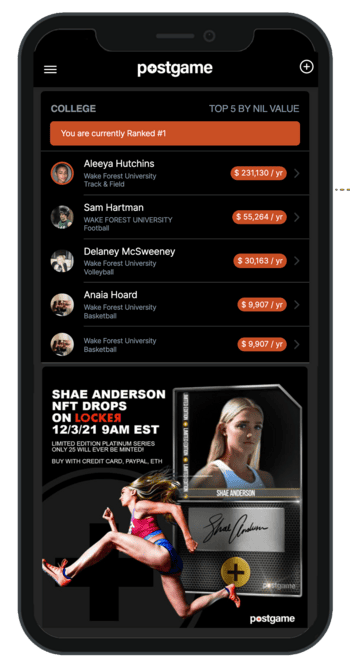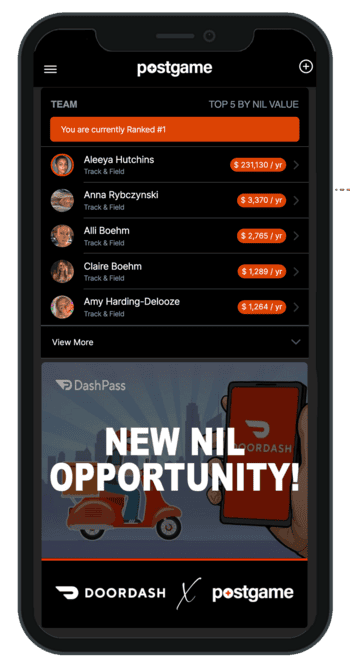The app that started as a way to measure student-athletes’ NIL value has grown to include branding services, an NFT marketplace, and “NIL Coin,” its own cryptocurrency.
Hardly a day goes by without significant cryptocurrency or NFT news coming across our feeds. The same could be said for college sports and major name, image, and likeness deals.
After starting as an app that could predict a college athlete’s monetary value, Postgame and founder Bill Jula are combining those two worlds.

NIL Coin, the first cryptocurrency made specifically for college athletes to make money, officially launched on Wednesday. It’s the latest and most profound evolution for a brand that began a year ago by anticipating upcoming changes to the college athletics landscape.
“The idea was to attract college athletes to join our platform to learn a little bit about their value,” Jula told Boardroom. “And then the athletes would download the app, join it, give us their Instagram, their email, their phone, all that good stuff, and then have an understanding of where they stood in the whole ecosystem of NIL and college athletics.”
While the company acknowledges that how much a player is worth isn’t an exact science, it is able to provide an estimate. When a player logs into the Postgame app, he or she will find an approximate yearly value next to their name and a ranking comparing them to the other 5,000 Postgame athletes. The algorithm that determines these rankings is based on athletic performance, market, social following, and position, among other criteria.
It was valuable information, even in the app’s formative months in late 2020 and early 2021 — long before the NCAA officially began allowing athletes to profit off their NIL rights.
“From December to July, the app more or less served the purpose of educating [athletes] on what their NIL value would be and what it’s like to turn themselves into a business,” Jula said.
That’s when word of the app spread among college athletes. Jula says Postgame would get an athlete on board, show them their worth, and they would naturally get their teammates and friends on other teams to join as well. It’s how Postgame began building its roster of talent, which came into play once NIL began and the brands came calling.
Phase I: Brand Services
July 1, 2021 will go down as one of the most significant days in the history of college athletics. From that point forward, student-athletes were able to start monetizing their personal brands. When that day hit, Postgame already had a database of thousands of college athletes and an estimate of how much it would cost brands to do a deal with them.

To start, Postgame had to go to brands and pitch their services, which wasn’t hard, considering everything it offers.
“We do everything for the brand, A to Z,” Jula said. “So we go to the brand, and we say, ‘hey, we’ve got 5,000-plus athletes on our network; who exactly are you trying to reach? What type of athletes are you trying to reach?’ And they give us a sense of what that is, we have a general sense of what their budget is at that point in time, and then we go on a kind of a recruiting campaign, to all of our athletes or to a subset of those athletes with the opportunity.”
While Postgame has its database of athletes, Jula notes that the company is not an agency and hasn’t signed any athlete to any sort of deal. Athletes merely provide Postgame their information in exchange for a value estimate and potential opportunities.
Another key difference: Because Postgame does not profit from the athletes and their deals directly, it is not only concerned with the high-level football or basketball players. It has successfully paired athletes from just about every sport with interested brands — be it for a one-off social post or an extended partnership.
“You can tell right away, most of the market was really fixated on the big one-off deals,” Jula said. “I didn’t think our chances of going and getting the attention of those guys from day one was going to be there. So my plan was: Let’s go far and wide with this and give the brands a different kind of opportunity than just putting all their eggs in that one basket with that big-name player. Let’s reach more followers with more athletes and less cost.”
Phase 2: NFT Marketplace
It only seemed natural that the next step for Postgame would be to dive into the NFT game, as the blockchain-powered phenomenon gives athletes the chance to do something on their own and invest in themselves.
When Postgame agrees to develop a non-fungible token for a player, he or she is given five for free, either to sell and make money from, or to bet on themselves, perhaps predict that they will go pro one day and their college NFTs will accrue more value over time. Digital collectibles sold in the marketplace are split 50/50 between Postgame and the athlete.
“Our vision is to be a conduit for these college athletes to earn money from their NILs,” Jula said. “Coming from technology background, like most of us are here, and watching the NFT space and seeing what was happening with NBA Top Shot and Candy dealing with Major League Baseball and all that, there’s definitely a void already in place. Not many people were doing college athlete NFTs as of a month or so ago.”
From Postgame’s perspective, it needs to be strategic around who gets an NFT. Jula says there are some simple criteria that the company uses. For one, the athlete needs to have a real chance to go pro, thus the value of their NFT won’t tank once the player’s college days are over.
Florida pitcher Hunter Barco was one of the early athletes to have an NFT in Postgame’s NFT marketplace. He’s the Gators’ ace and is a potential first-round pick in the 2022 MLB Draft. Postgame’s homepage touts that one of his NFTs sold for $850.
Opening up NFTs to college athletes also means bringing in a new audience of fans — older alumni, or simply people who have not been engaged with the likes of NBA Top Shot. Postgame isn’t in the business of explaining cryptocurrency to its customers, so it removed that barrier. Fans can shop on Postgame’s marketplace with a credit card or PayPal in addition to their MetaMask wallet. Soon, Postgame will provide another option for payment: NIL Coin.
Phase 3: NIL Coin
If your staff is tech-savvy enough, it’s only logical that the next step would be to go from dealing in cryptocurrency to actually creating one. So they did, officially debuting NIL Coin on Wednesday.
While NIL Coin was made with college athletes in mind, the hope is to have it available on crypto exchanges alongside Bitcoin, Ethereum, and the other big players.
When NIL Coin officially went live, Postgame and its athletes were ready to promote it across their Instagram feeds and stories. They will now have the opportunity to get paid to promote Postgame in US dollars, NIL Coin, or a combination of the two.
“It doesn’t necessarily have to be something that’s going to be limited to college athletics,” Jula said. “But because we have such a good starting point with 5,000-plus athletes in Postgame, it’s a no-brainer to launch the coin through this.”
NIL Coin is still in its infancy, but in just two full days since its launch, it was up over 200%. 200 of Postgame’s athletes are currently promoting the currency, and all of them will officially tie as the first student-athletes to be paid for a name, image, and likeness deal at least partially in NIL Coin.
Consider the era of the self-made NIL-lionaire officially minted.